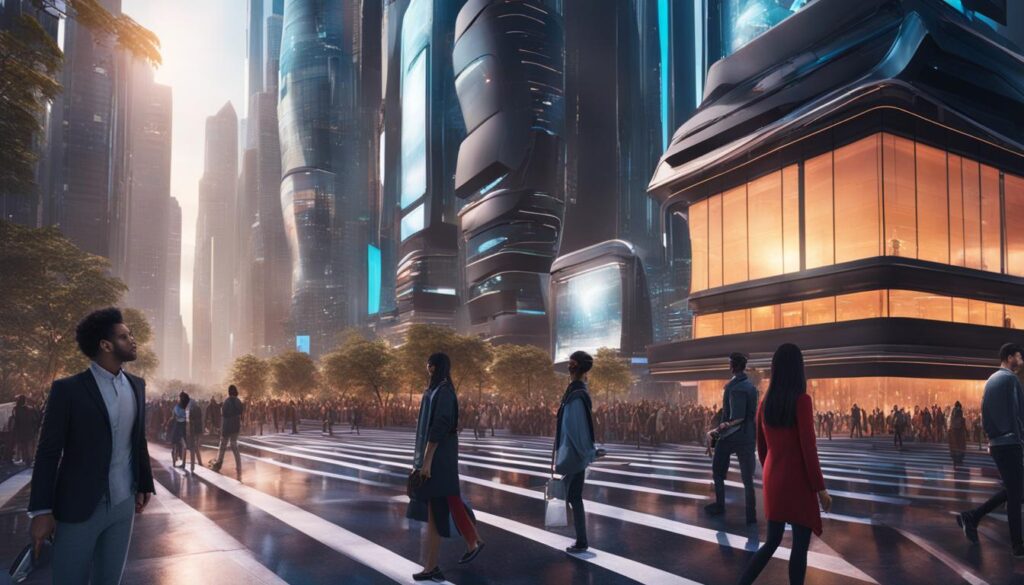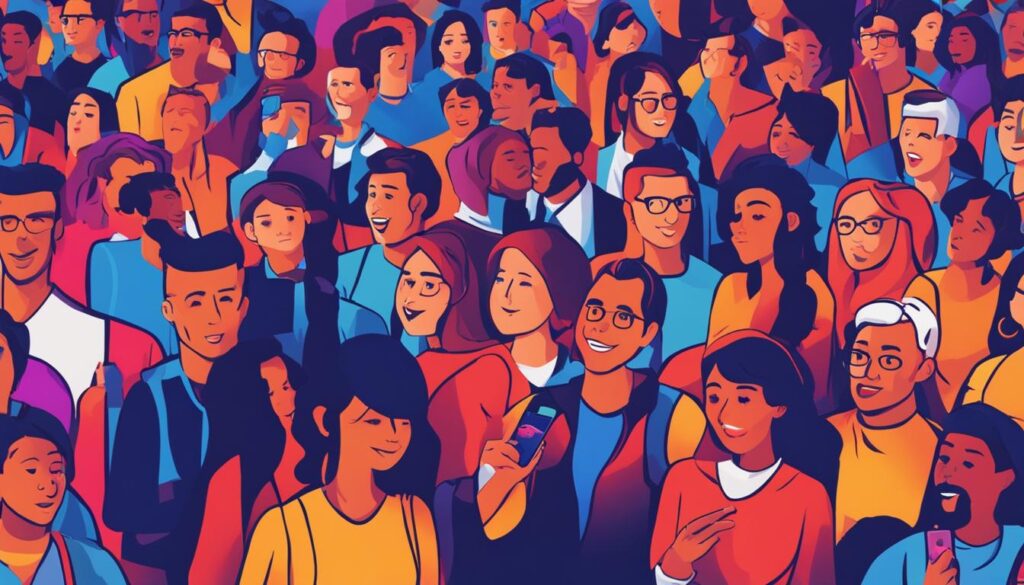Welcome to the future of influencer marketing, where hyper-realistic AI influencers are revolutionizing the digital landscape. These artificial intelligence influencers, also known as virtual influencers, are computer-generated digital characters that have the appearance and behavior of real influencers. They engage with followers, post captivating content on social media, and collaborate with brands to promote products and services.
Creating these hyper-realistic AI avatars is an intricate process that involves extensive research, personality crafting, and design. Companies meticulously study their target audience to understand their preferences and interests. From there, a compelling personality and narrative are developed, and physical traits are designed to resemble actual people. With the help of motion capture technology, these virtual influencers come to life, captivating audiences worldwide.
Virtual influencers have gained immense popularity, reaching massive followings and being admired by millions. One prominent example is Lil Miquela, a virtual influencer who has become one of the most influential and recognizable figures in the digital space. As these AI-generated influencers continue to grow in prominence, they are reshaping the landscape of influencer marketing and captivating a new generation of followers.
Key Takeaways:
- Hyper-realistic AI influencers, also known as virtual influencers, are computer-generated digital characters that resemble real influencers.
- They engage with followers, post content on social media, and collaborate with brands to promote products and services.
- The creation process involves extensive research, personality crafting, and design.
- Virtual influencers, like Lil Miquela, have gained immense popularity and influence on social media.
- They are reshaping the landscape of influencer marketing and captivating a new generation of followers.
What are Virtual Influencers?
Virtual influencers have emerged as a fascinating online phenomenon, blurring the lines between human and AI-generated content. These digital influencers, also known as virtual or AI influencers, are computer-generated characters that behave like real influencers on social media platforms.
Similar to their human counterparts, virtual influencers engage with their followers by posting content, building relationships, and collaborating with brands. They have gained a significant following, attracting attention and admiration from audiences worldwide.
Virtual influencers are part of a growing trend in influencer marketing, as brands recognize the unique opportunities they present. In the rapidly evolving digital landscape, these virtual personalities offer an innovative way for brands to connect with their target market and engage with younger audiences on social media platforms.
| Virtual Influencers | Digital Influencers | AI Influencers | Social Media Influencers |
|---|---|---|---|
| Resemble real influencers | Create content on digital platforms | AI-powered characters | Build relationships with followers |
| Engage with followers | Partner with brands | Post content on social media | Promote products and services |
| Gain a significant following | Attract attention and admiration | Blur the lines between human and AI | Connect with target market |
“Virtual influencers have become a popular marketing strategy for brands to reach younger audiences and engage with them on social media.”
What are Virtual Influencers?
Virtual influencers are computer-generated digital characters that act as influencers on social media platforms. They resemble real influencers in their behavior and activities, such as posting content, building relationships with followers, and partnering with brands. Despite not being real people, virtual influencers have gained a significant following and are considered an online phenomenon. They have become a popular marketing strategy for brands to reach younger audiences and engage with them on social media.

| Virtual Influencers | Digital Influencers | AI Influencers | Social Media Influencers |
|---|---|---|---|
| Resemble real influencers | Create content on digital platforms | AI-powered characters | Build relationships with followers |
| Engage with followers | Partner with brands | Post content on social media | Promote products and services |
| Gain a significant following | Attract attention and admiration | Blur the lines between human and AI | Connect with target market |
How are Virtual Influencers Made?
Creating virtual influencers involves a detailed and meticulous process that combines research, design, and technology. Let’s take a closer look at the steps involved in bringing these digital personalities to life.
The first step in creating a virtual influencer is conducting research to understand the target audience. This research helps to identify their preferences, interests, and demographics, which in turn inform the design and characteristics of the virtual influencer. By understanding the audience, creators can craft a persona and narrative that resonates with their followers.
Once the audience research is complete, it’s time to focus on the influencer’s personality and narrative. This includes defining their values, beliefs, interests, and unique traits that set them apart. The goal is to create a virtual influencer with a compelling story that connects with the audience on a deeper level.
The next step is influencer design, where the physical traits of the virtual influencer are developed. This process involves using motion capture technology to capture human movements and expressions, which are then translated into the digital character. The design team pays attention to every detail, from the influencer’s appearance and clothing style to their facial expressions and body language.
After the design is complete, a content creation team takes over the management of the virtual influencer’s activities. This team is responsible for creating engaging and relevant content, posting on social media platforms, interacting with followers, and collaborating with brands for sponsored content. In some cases, virtual influencers might rely on artificial intelligence to autonomously generate content based on predefined algorithms, making them semi-autonomous.

Table: Virtual Influencer Creation Process
| Step | Description |
|---|---|
| Research | Gather insights on the target audience’s preferences, interests, and demographics. |
| Personality and Narrative | Create a compelling persona and narrative that resonates with the audience. |
| Influencer Design | Develop the physical traits of the virtual influencer using motion capture technology. |
| Content Creation | Create engaging content, manage social media platforms, and collaborate with brands. |
Creating virtual influencers is a complex and multidisciplinary process that combines research, design, and content creation. It is through this process that these digital characters come to life, captivating audiences and engaging with them on social media platforms.
How are Virtual Influencers Perceived by the Public?
Virtual influencers have quickly gained popularity among the public, particularly among younger audiences. A recent survey conducted in the United States revealed that a staggering 58% of respondents followed at least one virtual influencer on social media. Among Generation Z, this number rose to an impressive 75%. These statistics indicate that virtual influencers have successfully captured the attention and engagement of their target audience.
What makes virtual influencers so compelling? One factor is their ability to generate high levels of engagement. In fact, virtual influencers receive three times more engagement than real influencers, demonstrating their significant influence over their followers. Furthermore, virtual influencers gain four times more followers for every post on Instagram compared to their real counterparts. These statistics highlight the effectiveness and appeal of virtual influencers in the digital space.
Despite not being real people, virtual influencers are perceived as authentic by their followers. They have established a sense of trust and relatability through their carefully crafted personas and engaging content. Their ability to resonate with their audience on a personal level has contributed to their popularity and success. Virtual influencers have become a new form of digital celebrity, capturing the attention and admiration of millions.

The Rise of Virtual Influencers
The rise of virtual influencers can be attributed to several factors. Firstly, their digital nature makes them easily accessible and relatable to younger generations who grew up immersed in technology and social media. Virtual influencers become a part of their online world, seamlessly blending in with the content they consume and the influencers they follow.
“Virtual influencers receive three times more engagement than real influencers and gain four times more followers for every post on Instagram.”
Secondly, virtual influencers offer a level of creativity and flexibility that real influencers may not be able to match. Brands have the opportunity to create and customize virtual influencers to align perfectly with their values and target market. This level of control allows for highly targeted and strategic influencer campaigns, increasing the effectiveness of brand messaging and product promotion.
Overall, virtual influencers have made a significant impact in the world of influencer marketing. Their popularity, engagement rates, and ability to resonate with their audience make them a powerful tool for brands and marketers. As technology continues to evolve, we can expect to see even more innovative and hyper-realistic virtual influencers capturing the attention and hearts of audiences worldwide.
Top Virtual Influencers You Should Know
Virtual influencers have become a prominent force in the world of social media, captivating audiences with their unique personalities and stunning visuals. Here are some of the top virtual influencers that you should know:
Lil Miquela
 One of the most influential virtual influencers in the industry, Lil Miquela has amassed a massive following and has been featured in numerous publications. With her distinct style and powerful messages, she has become a voice for inclusivity and social justice. Through her partnerships with various brands, Lil Miquela has solidified her position as a trendsetter and tastemaker in the digital space.
One of the most influential virtual influencers in the industry, Lil Miquela has amassed a massive following and has been featured in numerous publications. With her distinct style and powerful messages, she has become a voice for inclusivity and social justice. Through her partnerships with various brands, Lil Miquela has solidified her position as a trendsetter and tastemaker in the digital space.
Lu do Magalu
Created to promote Magazine Luiza, one of Brazil’s largest retail companies, Lu do Magalu has quickly risen to fame with her vibrant personality and commitment to social causes. With a focus on LGBTQ+ rights and environmental justice, Lu do Magalu uses her platform to educate and inspire her followers. Her authenticity and relatability have resulted in a huge social media following, making her a powerful advocate for positive change.
Rozy Oh
Hailing from South Korea, Rozy Oh represents the influential group known as “Generation MZ.” As a virtual influencer, Rozy Oh has appeared in commercials and campaigns, captivating audiences with her eye-catching visuals and engaging content. With her unique perspective and strong presence, she has become a symbol of empowerment for the younger generation.
Koffi Gram
Created by Diigitals, Koffi Gram is a fitness model virtual influencer who endorses luxury brands and promotes fitness-related products. With his sculpted physique and dedication to a healthy lifestyle, Koffi Gram inspires his followers to strive for greatness in their fitness journeys. His collaborations with popular brands have solidified his status as a go-to influencer in the fitness industry.
These virtual influencers represent a new era of digital influence, captivating audiences with their stunning visuals, unique personalities, and powerful messages. As they continue to gain popularity, their impact on the influencer marketing landscape is undeniable.
Benefits of Using Virtual Influencers
Using virtual influencers offers numerous benefits for brands looking to maximize their reach and impact in the digital space. Let’s explore the key advantages:
- Increased Reach: Virtual influencers have the ability to reach a vast audience on the platforms they utilize most. With their popularity among younger demographics, brands can tap into previously untapped markets and expand their reach.
- Lowered Brand Risk: By using virtual influencers, brands can minimize the risk of negative associations or controversies that can arise when working with real influencers. With virtual influencers, brands have full control over their behavior, ensuring alignment with the brand’s values and eliminating potential PR mishaps.
- Improved Product-Market Fit: Virtual influencers can be customized to fit perfectly with the brand’s target market. Through careful research and data analysis, brands can design virtual influencers that resonate with their audience, resulting in improved product-market fit and higher engagement.
- Minimized Costs: Owning a virtual influencer eliminates the need to negotiate salaries, travel expenses, and other costs associated with real influencers. This can significantly minimize marketing expenses and provide a cost-effective alternative for brands.
Using virtual influencers offers brands the unique opportunity to harness the power of authenticity, reach new audiences, and achieve their marketing goals while minimizing risks and costs.
Table: Benefits of Using Virtual Influencers
| Benefits | Description |
|---|---|
| Increased Reach | Tap into younger demographics and expand brand reach. |
| Lowered Brand Risk | Eliminate potential controversies and maintain full control over influencer behavior. |
| Improved Product-Market Fit | Create virtual influencers that resonate with the target audience for better engagement. |
| Minimized Costs | Reduce marketing expenses associated with real influencers. |
As brands continue to adapt to the ever-changing digital landscape, virtual influencers provide a compelling solution to drive brand awareness, engagement, and conversions. With their unique ability to captivate audiences and deliver tailored messaging, virtual influencers are a powerful tool for brands to consider in their marketing strategy.

Challenges of Using Virtual Influencers
While virtual influencers offer numerous benefits for brands, their utilization is not without its challenges. These challenges encompass a range of areas, from potential harmful social impact to legal implications and negative audience perception. Let’s explore some of the key challenges that arise when using virtual influencers:
Harmful Social Impact
One of the concerns associated with virtual influencers is the potential negative impact on followers’ self-esteem. These hyper-realistic avatars often adhere to specific beauty standards, which can perpetuate unrealistic ideals and contribute to feelings of inadequacy among impressionable audiences. Brands must consider the potential psychological effects that virtual influencers may have on their followers and take measures to promote healthy body image and self-acceptance.
Cross-Cultural Dilemmas
As virtual influencers gain global reach, brands face the challenge of navigating cross-cultural dilemmas. What may be acceptable or appealing in one culture could be considered inappropriate or offensive in another. It is crucial for brands to conduct thorough research and consult experts to ensure that virtual influencers are respectful of diverse cultures and do not inadvertently appropriate or misrepresent cultural elements.
Legal Implications
The use of virtual influencers raises various legal implications. In the realm of advertising, transparency is essential to maintain consumer trust. Brands must ensure that AI-generated content is clearly disclosed to the audience, avoiding any misleading or deceptive practices. Additionally, compliance with regulations regarding intellectual property, data privacy, and advertising guidelines is crucial to avoid potential legal issues.
Extensive Team Commitment
The successful management of virtual influencers requires a dedicated and committed team. From designing physical traits to crafting engaging content, a diverse set of skills is needed for their seamless operations. Brands must invest significant time and resources into maintaining a robust team capable of handling the complexities of virtual influencer management, content creation, and audience engagement.
Negative Audience Perception
Despite the growing acceptance of virtual influencers, there may still exist a negative perception among certain audiences. Some may view them as inauthentic or lacking credibility due to their non-human nature. It is essential for brands to continuously monitor and address these concerns to build trust and ensure that virtual influencers are perceived as valuable brand ambassadors.
As brands navigate the world of virtual influencers, it is important to be mindful of these challenges and proactively implement strategies to mitigate their impact. By considering the potential harmful social impact, cross-cultural dilemmas, legal implications, extensive team commitment, and audience perception, brands can maximize the benefits of virtual influencers while minimizing potential drawbacks.
The Role of AI in Influencer Marketing
AI has revolutionized the world of influencer marketing, offering a range of benefits to brands and marketers. With its advanced algorithms, AI enables personalization by providing targeted recommendations to users based on their preferences, interests, and behavior. This hyper-personalized approach helps brands to deliver relevant content to their target audience, resulting in increased engagement and conversion rates.
One of the key advantages of AI in influencer marketing is the ability to enhance engagement. AI algorithms can analyze massive amounts of data to identify the type of content that resonates most with users. By understanding audience preferences and interests, brands can optimize their influencer marketing strategies to deliver compelling and captivating content that drives meaningful interactions with their target audience.
In addition to personalization and enhanced engagement, AI also offers scalability in influencer marketing. With the help of AI-driven tools, brands can automate various tasks such as scheduling posts, analyzing data, and managing influencer relationships. This not only saves time and resources but also allows brands to scale their influencer marketing efforts effectively, reaching a wider audience and maximizing their impact.
AI-driven marketing tools, such as content creation and analytics, open up new possibilities for influencer marketing, enabling brands to continuously optimize their strategies and achieve better results.
The role of AI in influencer marketing is crucial for its future growth and success. As AI continues to evolve and improve, we can expect even more advanced tools and techniques to emerge, enabling brands to create highly targeted influencer campaigns that deliver exceptional results. By harnessing the power of AI, brands can reach their audience with relevant and engaging content, build strong relationships with influencers, and ultimately drive business growth in the digital age.

Table: Benefits of AI in Influencer Marketing
| Benefits | Description |
|---|---|
| Personalization | AI enables targeted recommendations based on user preferences, delivering personalized content to the right audience. |
| Enhanced Engagement | AI algorithms identify content that resonates with users, leading to higher engagement rates and meaningful interactions. |
| Scalability | AI automates tasks such as scheduling posts and analyzing data, allowing brands to scale their influencer marketing efforts efficiently. |
| AI-driven Marketing Tools | AI-powered tools empower brands to optimize content creation and analytics, unlocking new possibilities for influencer marketing. |
Case Studies of AI and Influence
We have witnessed the transformative power of AI in the realm of influencer marketing, giving rise to various innovative approaches and applications. Two notable case studies that exemplify the intersection of AI and influence are influencer bots and virtual reality influencers.
Influencer bots are AI-powered virtual entities that curate and disseminate fashion tips, tech reviews, and travel advice without the involvement of human influencers. These bots leverage advanced algorithms to analyze user preferences and generate personalized content, delivering tailored recommendations to their followers. With the ability to process vast amounts of data and adapt to evolving trends, influencer bots offer a cost-effective and scalable solution for brands seeking to engage with audiences in a highly targeted manner.
On the other hand, virtual reality influencers exist solely in the digital realm but have amassed real-life fan followings. These AI-generated characters blur the boundaries between the virtual and physical worlds, captivating audiences through immersive experiences. Virtual reality influencers engage with their followers through virtual reality headsets and interactive platforms, offering a glimpse into an augmented reality where their influence transcends conventional limitations. As the technology continues to mature, virtual reality influencers have the potential to redefine the landscape of influencer marketing, providing brands with entirely new avenues for captivating audiences.
AI has also revolutionized content generation in the influencer space. With AI-generated content, influencers can automate the creative process, producing blog posts, YouTube videos, and other forms of media at scale. By leveraging machine learning algorithms, AI can analyze vast amounts of data, identify relevant topics, and generate compelling and informative content. This not only enhances efficiency but also enables influencers to consistently produce high-quality content that resonates with their audience.
Case Study: AI-Generated Content
| Influencer | Platform | Content |
|---|---|---|
| AI Influencer A | Blog | AI-generated fashion tips |
| AI Influencer B | YouTube | AI-produced tech reviews |
| AI Influencer C | AI-generated travel guides |

As the AI landscape continues to advance, we can expect further innovations in the realm of influencer marketing. From influencer bots to virtual reality influencers and AI-generated content, the possibilities are constantly expanding. These case studies underline the immense potential of AI to revolutionize the way brands and influencers connect with their audiences and shape the future of influence.
Conclusion
In the ever-evolving landscape of influencer marketing, the future holds exciting possibilities with the integration of AI and influence. As technology continues to advance, we can expect to see hyper-personalized content tailored to individual preferences. AI algorithms will enable real-time engagement between virtual influencers and their followers, creating immersive experiences that bridge the gap between the digital and physical worlds.
The concept of hyperreal virtual influencers, indistinguishable from real humans, is on the horizon. These AI-powered avatars will revolutionize the influencer space, offering brands unprecedented opportunities for marketing and storytelling. With the ability to interact with followers in real-time, virtual influencers will provide authentic, personalized experiences that resonate with audiences on a deeper level.
However, as we embrace the future of AI and influence, it is essential to address the ethical considerations and potential challenges that arise. From ensuring transparency in advertising to maintaining cultural sensitivity, brands must navigate these complexities to build trust and credibility with their audience. Balancing the benefits of AI-driven influencer marketing with its potential drawbacks will be crucial in shaping a responsible and sustainable future.
With hyper-personalized content, real-time engagement, and the emergence of hyperreal virtual influencers, the future of AI-powered influencer marketing holds immense promise. As marketers and consumers alike, we are at the forefront of this exciting evolution, where creativity and technology converge to shape the digital experiences of tomorrow.
FAQ
What are hyper-realistic AI influencers?
Hyper-realistic AI influencers, also known as virtual influencers or AI influencers, are computer-generated digital characters that resemble real influencers in appearance and behavior. They post content on social media, build relationships with followers, and partner with brands to promote products and services.
How are virtual influencers created?
The creation of a virtual influencer involves a detailed process. It starts with researching the target audience to understand their preferences and interests. Based on this research, a personality and narrative for the influencer are crafted. The influencer’s physical traits are then designed to resemble an actual person, using motion capture technology to bring them to life. Content creation and interaction with followers are usually handled by a team behind the scenes, although there are some virtual influencers who are semi-autonomous and rely on artificial intelligence for their personality and appearance.
How popular are virtual influencers?
Virtual influencers have gained popularity among the public, especially among younger audiences. A survey conducted in the United States revealed that 58% of respondents followed at least one virtual influencer on social media. Among Gen Z, 75% reported following a virtual influencer. Virtual influencers receive three times more engagement than real influencers and gain four times more followers for every post on Instagram. Despite not being real people, virtual influencers seem to have a significant influence on their followers and are perceived as authentic in the digital space.
Who are some notable virtual influencers?
There are several notable virtual influencers in the world. Lil Miquela, one of the most famous virtual influencers, has amassed millions of followers and has been named one of TIME Magazine’s most influential people on the internet. Lu do Magalu, created to promote Magazine Luiza in Brazil, has a massive social media following and advocates for LGBTQ+ rights and environmental justice. Rozy Oh, a South Korean virtual influencer, represents the influential group known as “Generation MZ” and has appeared in commercials and campaigns. Koffi Gram, a fitness model created by Diigitals, endorses luxury brands and fitness-related products.
What are the benefits of using virtual influencers?
Using virtual influencers offers several benefits for brands. They can reach younger audiences on the platforms they use most and can be in multiple places at once. Virtual influencers also allow brands to have full control over their behavior and can be customized to fit perfectly with the brand’s values and target market. Additionally, owning a virtual influencer can minimize costs as there is no need to negotiate salaries or deal with potential controversies associated with real influencers.
What challenges do virtual influencers present?
Despite their benefits, virtual influencers also pose challenges. Their presence can have a harmful impact on followers’ self-esteem due to the specific beauty standards they adhere to. As global markets are targeted, cross-cultural challenges may arise, and brands need to be careful not to misappropriate cultural elements. Legal implications may arise, such as transparency in advertising and disclosure of AI-generated content. Maintaining virtual influencers over time requires consistent commitment from teams, and there may be concerns about the authenticity and credibility of virtual influencers among the audience.
What is the role of AI in influencer marketing?
AI plays a significant role in influencer marketing. It enables personalization by providing targeted recommendations to users based on their preferences. AI algorithms can predict what type of content keeps users engaged and provide deep insights into audience behavior. AI also helps in scalability by automating tasks such as scheduling posts, replying to comments, and outreach efforts. AI-driven marketing tools, such as content creation and analytics, open up new possibilities for influencer marketing.
Are there any case studies of AI and influence?
AI has enabled the creation of influencer bots that curate fashion tips, tech reviews, and travel advice without the need for human influencers. Virtual reality influencers exist in the digital realm and have real-life fan followings. AI also contributes to the generation of content, such as blog posts and YouTube videos, automating the creative process.
What does the future hold for AI-driven influencer marketing?
AI and influence have the potential to shape the future of digital experiences. Despite ethical concerns, the synergy between AI and influence can lead to hyper-personalized, highly engaging content. The future may bring advancements in personalization, real-time engagement with virtual influencers, and the emergence of hyperreal virtual influencers who are indistinguishable from real humans. The future is poised for an exciting evolution in the world of AI-driven influencer marketing.











